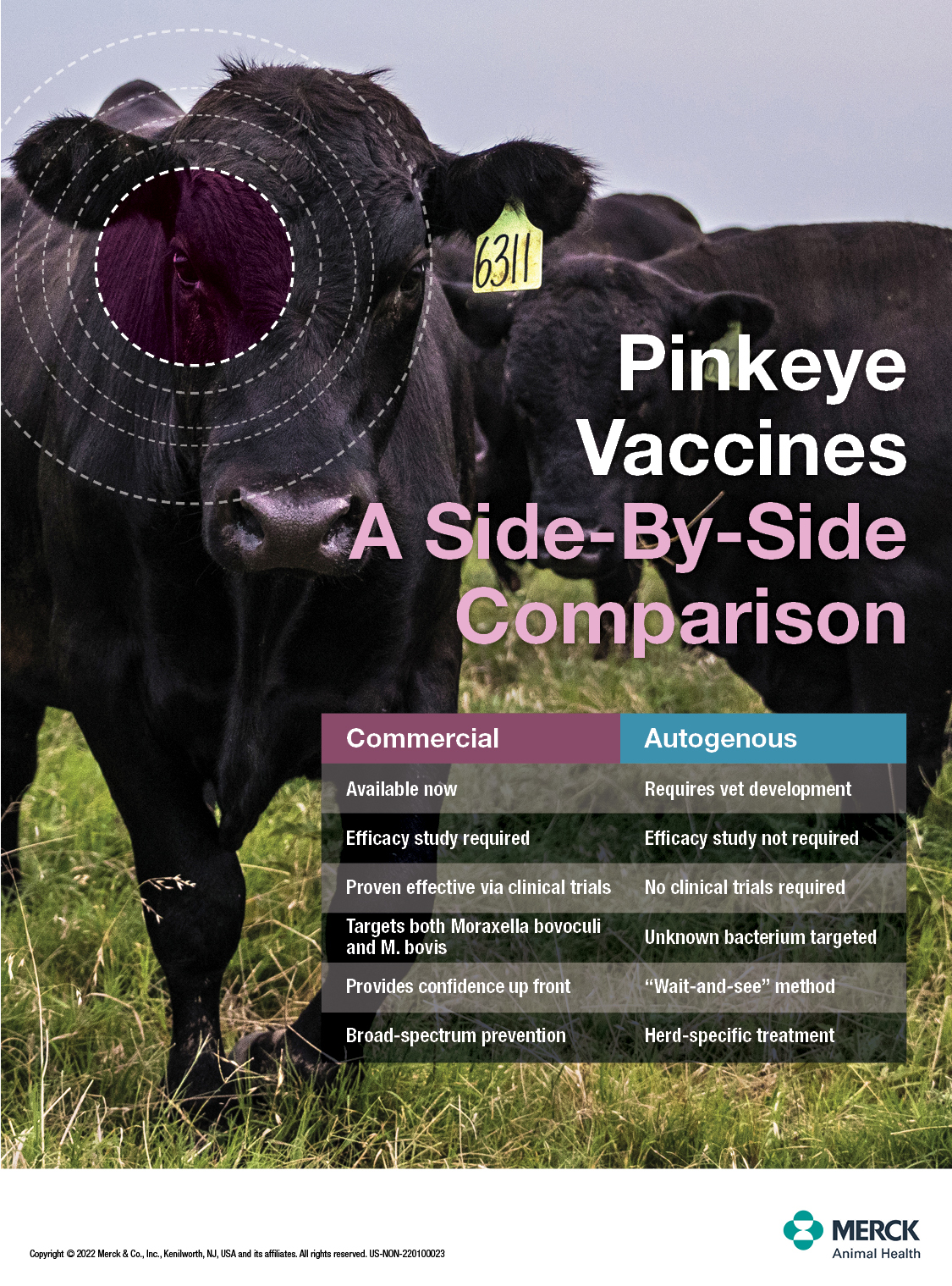Pinkeye Vaccine – Commercial, Autogenous or Both?
Download PDF
Experts weigh in.
Bovine pinkeye. It seems to happen every summer. Even though it may look the same in different animals, potential causes and opinions on what vaccines are most effective vary. On one hand there are commercial vaccines developed and tested by trusted animal health/biologics manufacturers. On the other there are autogenous vaccines created from specific microorganisms affecting a herd. Knowing what is best to recommend to prevent this costly disease can be a challenging dilemma.
Dr. Lowell Midla, VMD, MS, veterinary technical services manager with Merck Animal Health, and a beef cattle producer, has a lot of experience with both types of vaccines for preventing pinkeye. “To the best of my knowledge, right now, there have been five studies with autogenous vaccines, and those autogenous vaccines were studied in a controlled setting—out in the field,” says Midla. “In all five of those studies, the autogenous failed to prevent pinkeye. So, that's at least one advantage of commercially available vaccines over autogenous.”¹
“It must be remembered autogenous vaccines have no requirement to prove efficacy via clinical trials,” adds Midla. Autogenous vaccines are only required to be produced by a licensed lab under the approval of a vet or specialist. “They are only required to show they do no harm, that they're safe. Commercial vaccines, however, have to show efficacy in their trials to be marketed to the public.”²
Autogenous pinkeye vaccines based on Moraxella bovis/bovoculi are typically created from bacteria cultured from pinkeye-affected animals during that pinkeye season. Vaccines are then produced for use later that year or in the following year, depending on how long it takes to produce the vaccine. The disease has to be present in order to collect the original isolates, and therefore it may be too late to effectively prevent the disease that season, but may be useful for prevention when used the following year. In some situations autogenous vaccines can be made from older isolates (with approval) and may be useful in disease prevention programs. According to Dr. John Angelos, professor in the Department of Medicine and Epidemiology, School of Veterinary Medicine, UC Davis: “The general dogma is that for an autogenous vaccine to be most effective, it should be based on isolates currently circulating in a herd. Ideally, these would be based on current isolates, but regulations allow for older isolates to be used in certain circumstances.” Regardless, it is ideal to pinpoint a specific strain(s) while it’s still present and causing infections in a herd.
Angelos also weighs in with wise words for veterinarians and their producers. “My advice to veterinarians and cattle producers as to whether to use autogenous, commercial or combinations of autogenous/commercial have generally been based on many different considerations. I do not think there is a one-size-fits-all approach to making such recommendations. Some of the things I like to know when trying to come up with a recommendation include: What is the herd vaccine history; how well (or not) has a vaccine (autogenous or commercial) been perceived to be performing in controlling pinkeye for a herd; what have the results been of any eye culturing that might have been done; and how much is a producer willing to invest in a pinkeye control program. Answers to these and other questions can greatly help in developing vaccination recommendations.”³
Deciding what type of vaccine is best for a herd can be complicated, and that’s why now is the time to start that conversation with your clients. Weighing the pros and cons, as well as knowing what will best serve their particular herd, can benefit them for years to come.
For more information on managing pinkeye, visit https://www.bovinevetonline.com/news/education/pinkeye-prevention-preferred
For more information on pinkeye vaccination, visit StopCattlePinkeye.com.
¹ D.E. Hughes, G.W. Pugh Jr., R.H. Kohlmeier, G.D. Booth, and B.W. Knapp, “Effects of Vaccination with a Moraxella bovis Bacterin on the Subsequent Development of Signs of Corneal Disease and Infection with M. bovis in Calves Under Natural Environmental Conditions” (American Journal of Veterinary Research, 1976, 37, 11), 1291-1295; A. K. Arora, A. H. Killinger, and M. E. Mansfield, “Bacteriologic and Vaccination Studies in a Field Epizootic of Infectious Bovine Keratoconjunctivitis in Calves” (American Journal of Veterinary Research, 1976, 37, 7), 803-805; Harriet J. Davidson and Gerald L. Stokka, “A Field Trial of Autogenous Moraxella bovis Bacterin Administered Through Either Subcutaneous or Subconjunctival Injection on the Development of Keratoconjunctivitis in a Beef Herd” (The Canadian Veterinary Journal, 2003, 44, 7), 577–580; L. Funka, A.M. O’Connor, M. Maroney, T. Engelken, V.L. Cooper, J. Kinyon, and P. Plummer, “A Randomized and Blinded Field Trial to Assess the Efficacy of an Autogenous Vaccine to Prevent Naturally Occurring Infectious Bovine Keratoconjunctivis (IBK) in Beef Calves” (Vaccine, 2009, 27, 34), 4585–4590; and A.M. O’Connor, S. Brace, S. Gould, R. Dewell, and T. Engelken, “A Randomized Clinical Trial Evaluating a Farm-of-Origin Autogenous Moraxella bovis Vaccine to Control Infectious Bovine Keratoconjunctivis (Pinkeye) in Beef Cattle” (Journal of Veterinary Internal Medicine, 2011, 25,6), 1447–1453.
² Lowell Midla, interview by Tracy Stone, September 29, 2021.
³ John Angelos, interview by Tracy Stone, October 1, 2021.








